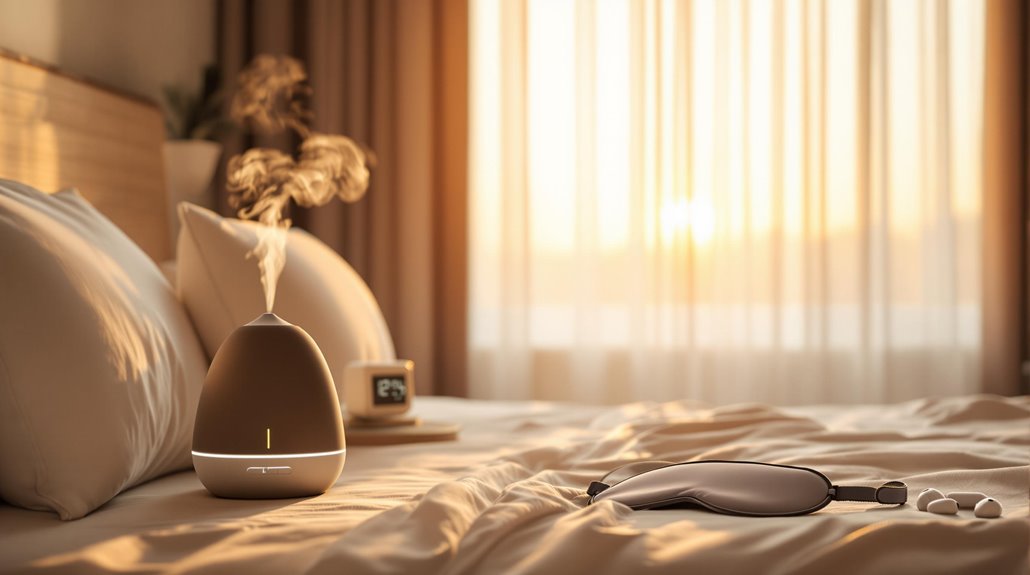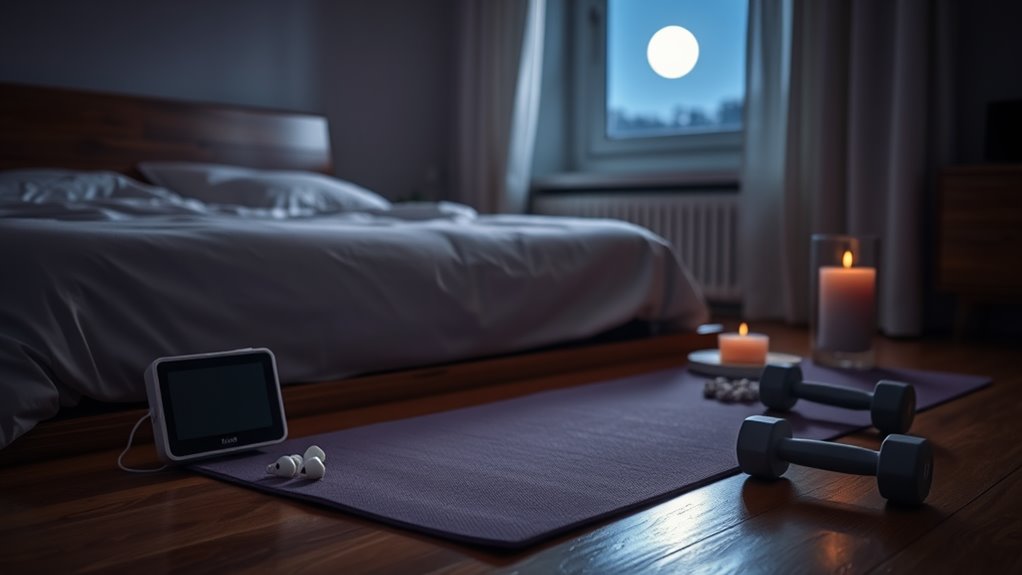
You’re balancing unpredictable hours, so prioritizing your sleep is key. Communicate your schedule to reduce interruptions, and stick to a consistent sleep routine. Optimize your sleep environment by ensuring a cool, dark, and quiet space. Manage light exposure with sunnier surroundings early in your shift and dimming lights later. Establish a soothing bedtime routine adapted around your shifts. Take strategic short naps to keep alertness up without overwhelming sleep inertia. Limit caffeine intake and fuel up with balanced meals. Incorporate regular, short exercises to align energy levels. Explore further to enhance your shift work sleep hygiene practices effectively.
Prioritize Sleep
Prioritize Sleep
Why is prioritizing sleep critical for shift workers? Well, it’s the secret to thriving in an unconventional lifestyle. You’re juggling irregular hours; without solid sleep priorities, your well-being may unravel. Anxiety and stress caused by irregular schedules can elevate heart rates and disrupt melatonin production, further affecting sleep quality.
Start by establishing open sleep communication with friends, family, and neighbors. They need to understand your commitments to minimize interruptions—ensuring you get the rest you deserve.
You can transform your shift-based life by aligning social activities and household tasks with your sleep times. Make sure your loved ones know your work schedules as well, offering a chance for them to support you by adjusting their expectations. It’s also important to limit screen time and bright light exposure before bedtime to enhance sleep quality.
When planning your days off, stick to the same sleep-wake schedule. Consistency keeps your body clock in tune, avoiding abrupt sleep time changes that could disrupt your balance.
Embrace gradual schedule adjustments for smooth shifts between shifts. This subtle tweak maintains harmony in your body’s rhythm.
And to enhance your freedom, firm control over lifestyle factors plays a pivotal role. As you regulate caffeine, meal times, and screen usage, you empower yourself to enjoy restorative sleep, enabling you to handle shift work challenges without missing a beat.
Prioritizing rest is the first step towards reclaiming control over your life.
Create a Comfortable Sleep Environment
Creating a comfortable sleep environment involves several key elements that can greatly enhance your rest quality. This begins with mastering temperature control.
Maintaining a comfortably cool room between 16-20ºC (60-68ºF) helps you avoid overheating, which often disrupts sleep. Use air conditioning or fans if necessary, and guarantee your space is well-ventilated for ideal air quality. It’s essential to limit exposure to blue light from screens before bedtime, as it inhibits melatonin production and can significantly disrupt your sleep cycle.
In addition, mastering soundproofing techniques can shield you from intrusive noises that interfere with slumber. Try closing windows and doors, investing in earplugs, or utilizing white noise machines. If external noises persist, noise-cancelling headphones might be your liberating ally.
Consider your sleep space organization as another essential step. Keep your bed exclusive for rest and intimacy; avoid clutter, and steer clear of mentally stimulating activities nearby. Confirm the bed itself is both comfortable and supportive for a truly restful experience. Shift workers face a higher risk of sleep deprivation, which makes optimizing your sleep environment even more crucial for maintaining overall health and wellbeing.
Here’s how you can enhance your space:
- Temperature Control: Keep your room cool and airy.
- Soundproofing Techniques: Block noise and enjoy serene silence.
- Maximize Darkness: Use blackout blinds or eye masks to create nighttime vibes.
- Organize Your Sleep Space: Maintain a clutter-free, calm zone for peace.
Reclaim your sleep, crafting an undisturbed, extraordinary rest space.
Manage Light Exposure and Screen Time

To effectively manage light exposure and screen time as a shift worker, you need strategic use of light during your work hours and afterward.
Begin by immersing yourself in bright light at the start of your night shift to boost alertness. Using blue-enriched lighting can accelerate your circadian adjustment, helping you stay vigilant. As the shift progresses, shift to dimmer settings, promoting easier sleep when you return home.
Utilizing circadian-informed lighting not only synchronizes with your shift schedule but also respects your body’s natural rhythms.
Once the shift ends, reduce your light exposure to prepare for daytime rest. Wearing blue light-blocking glasses or sunglasses can be a liberating practice, minimizing melatonin-suppressing light during your journey home.
Regular physical activity can also enhance sleep quality, providing deeper rest and better regulation of your circadian rhythms post-shift.
Install blackout shades in your bedroom to create the dark sanctuary you need for quality sleep.
When it comes to screens, be proactive. Employ screen filters to limit exposure to blue light from devices. This simple step aids in maintaining your circadian balance.
Develop a Bedtime Routine
A consistent bedtime routine is a shift worker’s secret weapon for ensuring restful sleep. Liberate yourself from restless nights by embracing bedtime rituals that lead to soothing slumber.
Start by incorporating relaxation techniques into your evening. A hot shower or bath washes away the day’s stresses, preparing you for rest. Meditate or engage in calming activities to gently slow your mind.
Here’s how you can effectively develop a bedtime routine:
- Embrace Relaxation Techniques: Each night, practice deep breathing or gentle stretching exercises, letting your body know it’s time to wind down.
- Craft a Peaceful Environment: Make your bedroom a sanctuary. Dim the lights and keep your space quiet, using ear plugs or white noise if necessary.
- Draw the Line at Screens: Avoid mentally stimulating activities in bed, like working on a laptop or engaging in bright-screened entertainment.
- Stay Consistent: Go to bed at the same time each night, aligning your body’s natural rhythms and signaling it’s time to sleep.
Incorporate morning exercise into your routine; it boosts heart rate and releases endorphins, energizing your day and helping you adjust to different shifts.
Free yourself from the chaos of irregular sleep by nurturing these habits, and let bedtime become a cherished pause in your busy life. Your body and mind will thank you.
Manage Naps and Sleep Inertia

To stay alert during your shift, consider taking short naps of 10-20 minutes, which can boost your energy without causing grogginess. Plan your naps carefully to combat sleep inertia, allowing yourself at least 15-20 minutes to wake up fully before engaging in demanding tasks. Incorporating mindfulness practices into your routine can further enhance your alertness and decrease stress, making it easier to adjust between sleep and waking hours.
Short Nap Benefits
For shift workers, effectively managing naps is essential to maintain alertness and combat sleep inertia. You might wonder how to fit naps into your shift schedules without causing disruption. By choosing the right nap strategies, you can enhance your shift experience and overall well-being.
Here’s why short naps can be your best ally:
- Boost Alertness: During night shifts, short naps can considerably improve your alertness. This means you’ll make fewer mistakes and stay sharp when it matters most.
- Reduce Fatigue: A 20-30 minute nap can refresh you, reducing daytime drowsiness and making those long shifts more manageable.
- Enhance Performance: Need a cognitive pick-me-up? Short naps help boost memory, logical reasoning, and precision, making you a more effective problem-solver.
- Improve Mood: Remaining positive and attentive is critical during demanding shifts, and a quick nap can give your mood the lift it needs to tackle challenges head-on.
Timing matters too. Consider taking naps before 4 AM to align with your natural sleep cycle, especially during night shifts.
Keep naps under 30 minutes to avoid entering deep sleep and potentially waking up feeling groggy. Embrace this strategy to liberate yourself from fatigue and revel in improved performance.
Overcoming Sleep Inertia
Waking up groggy? You’re experiencing sleep inertia, a sluggish state after waking, hindering your cognitive performance. For shift workers, overcoming this is essential. Sleep strategies can make a big difference.
First, tackle naps wisely. A 10-20 minute nap perks you up without plunging into deep sleep, which amplifies inertia. Ever tried a “coffee nap”? Sip some coffee and doze for 15-20 minutes; you’ll wake as caffeine kicks in, reducing grogginess.
Here’s a handy guide:
| Situation | Nap Strategy |
|---|---|
| Early afternoon feeling | 10-20 minute power nap |
| Post-lunch lull on night shift | Short, timed nap if job allows |
| Quick refresh needed | Coffee nap (15-20 min) |
| Feeling too close to a shift | Avoid napping |
Scheduling is key. Stick to a consistent sleep schedule, even off duty. Gradually shift your sleep times if rotating shift patterns. Encourage your loved ones to respect your downtime, and adapt your environment for ideal rest—cool, dark, and quiet.
Lastly, avoid risky tasks during inertia. Let the light in—gradual exposure to natural light awakens your senses and sharpens cognitive performance. With these strategies, reclaim control over your energy and alertness.
Monitor Diet and Caffeine
Many shift workers struggle with maintaining proper sleep hygiene due to irregular hours, but your diet and caffeine intake can make a significant difference.
By focusing on meal planning and hydration strategies, you’re empowered to optimize your energy and improve your sleep quality. Avoid heavy meals before bed and instead, focus on balanced options before your night shift.
Here’s how you can take charge:
- Plan Ahead for Meals: Prepare nutritious meals ahead of time, like soups or casseroles with whole-grain ingredients, to avoid fast food temptations. This helps maintain energy and supports sleep quality.
- Stay Hydrated: Drink up to 64 ounces of water daily and avoid sugary beverages. Staying hydrated is essential for alertness and combating fatigue. Keep a water bottle handy during your shift.
- Choose Sleep-Friendly Snacks: Opt for snacks like hummus and fresh veggies instead of sugary treats. These choices provide sustained energy without crashes.
- Limit Caffeine: Avoid caffeine 3-6 hours before bedtime and consume it early in your shift. Stick to moderate amounts for a balanced energy boost that won’t impact your sleep.
Exercise and Manage Rotating Shifts

Finding time for exercise can be challenging for shift workers, but it’s essential for managing stress and improving sleep quality. Embrace the exercise benefits by integrating workout strategies into your routine, even if it’s just 5-10 minutes of activity.
Strength training offers efficiency in improving cardiovascular health and reducing risks linked to shift work, so aim to incorporate it when possible.
Strategize your workout plans around your shifts. Opt for short workouts before or after shifts based on how energetic you feel. Consider breaking up exercise into manageable segments like squats or push-ups during breaks. Attach these sessions to regular events, rather than rigid times—liberate yourself from a strict schedule.
Paying attention to your body’s internal clock matters. Habitual exercise at consistent times aids in aligning your circadian rhythm and boosting sleep quality. Favor forward-rotating shifts to minimize disruption, and avoid early morning starts to prevent fatigue.
Enhance motivation through group workouts, which can be fun and engaging. Leverage technology to keep your workouts interesting and connected.
Prioritize your well-being by choosing adaptable activities and ensuring adequate rest—it’s the key to thriving in rotating shifts.














